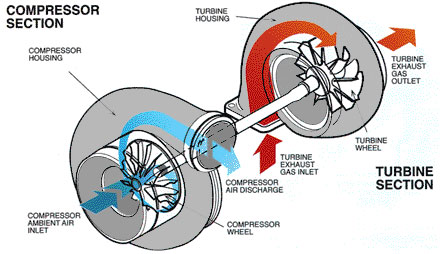Though not all consumers want greater power under the hood, gearheads exist for every brand. Their appetite for an extra boost compel automakers to offer turbochargers and other features that crank up the horsepower or torque. After-market companies also manufacture parts and accessories to supplement stock power and acceleration. One of the most popular methods to increase output is the turbocharger; now, before you purchase a higher trim or after-market product, let us delve into the benefits and detriments of this feature.
First, it would behoove us to describe how a turbocharger functions.
Turbochargers
The standard internal combustion engine relies on a consistent supply of air to effectively ignite fuel. Air molecules are vital; the more of them that are pumped into the cylinders, the more powerful the resulting explosion can be.
Production vehicles, though, are purposefully engineered to supply less than the maximum amount of molecules the engine could handle. This results in performance that is sub-premium. A turbocharger adjusts this deficiency.
Turbochargers utilize a turbine propelled by the exhaust system. This design allows a compressor to function, which forces more oxygen into the cylinder. The result: a potential of 30-40% more powerful than a standard engine.

Photo via XSpeed
This sounds great, doesn’t it? Well, it absolutely can be. The unfortunate reality, however, is that turbochargers are like any other awesome thing in life – it can have drawbacks. Here are two things to think about before you spend the money to get that sweet boost.
Lag Time
A turbocharger can only operate at the rate gas flows through the exhaust manifold. As a result, there is a moment of lag in response time when you hit the accelerator. Still, once it does take effect, it’s unbelievably fun.
For extra money, you could compensate for this with lighter blades or installing two turbines. One of the turbines would be smaller, which would kick in quickly; the other would be bigger, which sustaints high-speed driving.
If you’re married, you may first want to consult with your wife – though we think a few nights on the couch is worth a lifetime of turbocharged fun. If you’re unmarried, do what you want!
Knocking
Turbochargers have the potential to create an amount of pressure within the cylinder that causes the fuel and air mixture to detonate before the plug fires. This causes a knocking sound, which is a common complaint among vehicle owners with this extra power supply. Knocking can degrade performance and harm the engine. If this should happen, you need to seek a well-trained technician to handle the issue.
Less than Optimal Results
If a technician properly installs and configures a turbocharger, the vehicle receives a tremendous boost. Should you have approached a substandard technician, you face potential pitfalls…
- A turbocharger adds more air to the cylinders, but not actual air molecules. This is an issue because, well, the greater volume of molecules is the entire point of the project. You can counter the issue by cooling the air that flows into the cylinders – but for a steeper price tag.
- Computer chips that control vehicle operations may inject only a preprogrammed amount of gas into the cylinders. This is problematic because when a turbine adds air to the mix, added fuel is also needed so it doesn’t run too lean. You can eliminate this problem by re-programming or replacing the chip.
Our Thoughts
A turbocharger can effectively and easily add much more gusto to your vehicle. While we did present a few drawbacks, the point wasn’t to dissuade you as they can be mitigated or even eliminated. When you properly plan and install a turbocharger, if you’re a true gearhead, you’ll quickly realize that the juice was worth the squeeze.

Comments are closed.